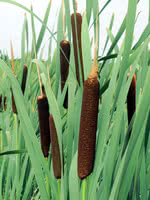Mon-Fri 9am - 5pm Mountain time
Common Cattail vs Pearly Everlasting
Anaphalis margaritacea
Typha latifolia
CUSTOM GROW
CUSTOM GROW
Pearly Everlasting is a native perennial wildflower known for its clusters of white, papery flowers with yellow centres. These long-lasting blooms appear throughout summer, and the silver-grey foliage adds contrast to the landscape. Its nectar supports a variety of pollinators and serves as a host plant for painted lady caterpillars.
Pearly Everlasting is also used in dried flower arrangements. It is well-suited for pollinator gardens, naturalization, ecological restoration, and low-maintenance landscapes.
Cattail is found all across North America, growing next to water. Like other waterside plants, Cattail provides erosion control and forage for animals.
It is suitable for land reclamation. Cattail is able to tolerate cold weather and occasional flooding.

